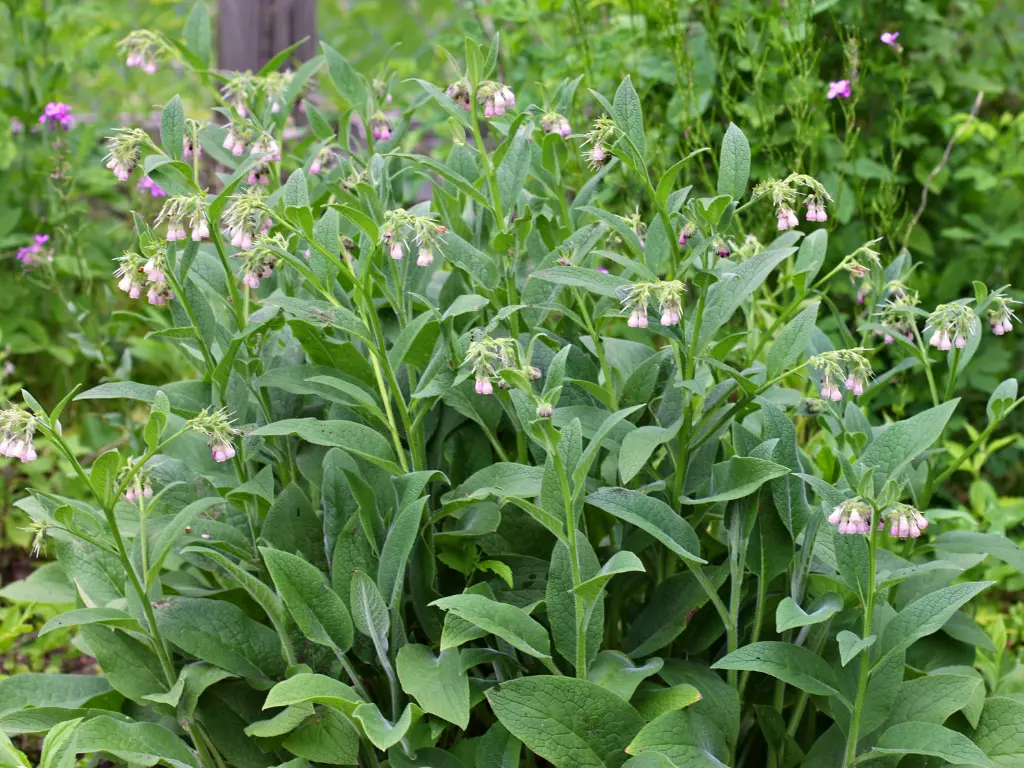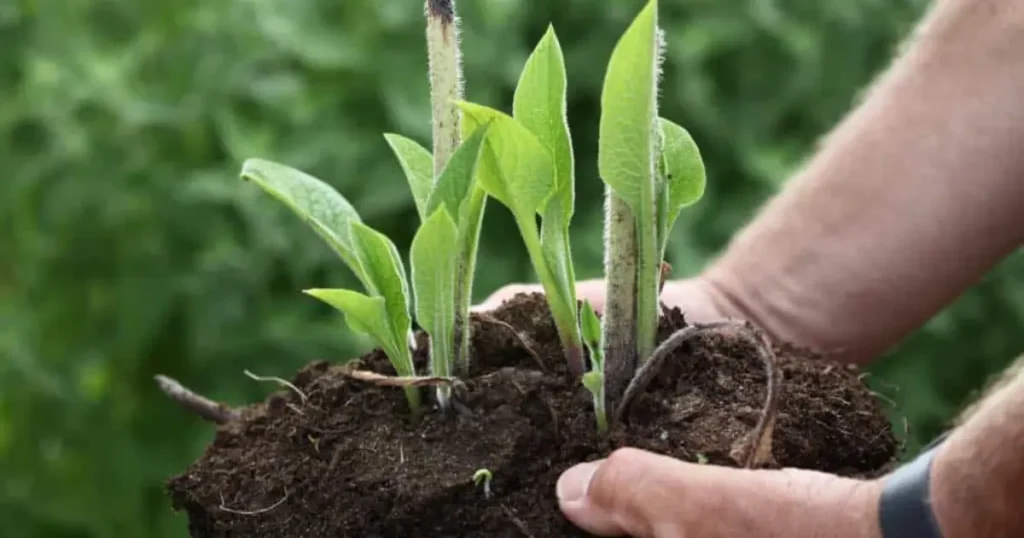If you’re looking to grow your own healthy comfrey plants without spending too much, propagating comfrey from root cuttings is an easy and effective method. I know what you’re thinking – “But how do I actually do it?” Don’t worry, I’m here to walk you through every step of the process. Whether you’re a beginner gardener or an experienced one, this guide will help you learn how to propagate comfrey successfully. By the end of this post, you’ll not only understand how to Propagate Comfrey from Root Cuttings but also have the knowledge to ensure your plants thrive.
What is Comfrey, and Why Should You Grow It?

If you’ve never heard of comfrey (Symphytum officinale), you’re missing out on a real gem of the plant world. Comfrey is a perennial herb with a long history of use in herbal medicine, it’s often used in natural remedies for wounds and inflammation, and it’s also fantastic as a nutrient-dense fertilizer for other plants in your garden.
It’s also an incredible plant for improving soil health—its deep roots mine minerals and nutrients, making it a perfect addition to any garden.
But beyond its medicinal and soil-enhancing properties, comfrey has another amazing benefit: it’s incredibly easy to propagate. So, if you’ve got one plant, you can easily grow more, without needing to buy new plants each season.
Whether you’re growing comfrey for its health benefits, as a fertilizer, or simply because you love its beautiful foliage, learning how to propagate comfrey from root cuttings is a great way to expand your collection.
Buy Comfrey Root Cuttings here:
5 Russian Comfrey Live Root Cuttings -Bocking 14 Cultivar – Comfrey Roots for Growing
Why Propagate Comfrey from Root Cuttings?

You might be asking, “Why choose root cuttings to propagate comfrey? Can’t I just plant seeds or take cuttings from the stem?”
The truth is, root cuttings are one of the most reliable and easiest ways to propagate comfrey. When you use root cuttings, you’re ensuring that the new plants are clones of the original, which means they will have the same beneficial properties as the parent plant. Plus, with this method, you get fast results. Root cuttings can sprout into full-fledged plants within just a few weeks!
What You’ll Need to Propagate Comfrey from Root Cuttings
Before you get started, gather the following materials:
-
Healthy comfrey plant: You’ll need a healthy parent plant to take root cuttings from.
-
Sharp knife or garden shears: For cutting the roots without damaging them.
-
Container for the cuttings: A pot or container where you can plant the root cuttings.
-
Well-draining soil: Comfrey prefers well-draining soil that retains moisture but doesn’t stay soggy.
-
Rooting hormone (optional): While not always necessary, a rooting hormone can speed up the rooting process.
Step-by-Step Guide to Propagating Comfrey from Root Cuttings

Now that you’re ready, let’s break down the process into easy-to-follow steps. Don’t worry – you’ll get the hang of it in no time!
Step 1: Choose a Healthy Parent Plant
Start by selecting a healthy comfrey plant. Look for a mature plant with strong, well-established roots. The best time to take root cuttings is in the early spring or fall when the plant is in its dormant or semi-dormant phase.
Step 2: Dig Up the Parent Plant
Carefully dig up the comfrey plant, exposing the roots. Be gentle to avoid damaging the root system. You don’t need to remove the entire plant from the soil, but you will need to access the root system.
Step 3: Cut Healthy Roots
Next, you’ll want to cut a portion of the root. Using a sharp knife or garden shears, take a healthy, thick root section around 4-6 inches long. Make sure the cutting has some buds or growth points, as this will help it sprout into a new plant. If you’re not sure which parts of the root to cut, look for roots that are firm and free of disease.
Step 4: Prepare the Cuttings
Once you’ve cut the roots, you can optionally dip the cut ends in rooting hormone to encourage faster root growth. This step is not necessary, but it can help if you’re looking for quicker results.
Step 5: Plant the Root Cuttings
Prepare a container with well-draining soil. Make small holes in the soil and place each root cutting horizontally, ensuring the cut ends face down. Cover the cuttings lightly with soil. Avoid burying them too deep, as the roots only need to be a couple of inches below the surface.
Step 6: Water and Maintain
After planting, water the cuttings lightly to settle the soil. Keep the soil moist but not waterlogged. Place the container in a location with bright, indirect sunlight. It may take a few weeks for the cuttings to establish roots and begin sprouting new growth.
Step 7: Transplanting to the Garden
Once the comfrey root cuttings have sprouted and grown strong, it’s time to transplant them into your garden or larger pots. Be sure to harden the plants by gradually introducing them to outdoor conditions if you started them indoors.
Common Mistakes to Avoid When Propagating Comfrey from Root Cuttings
While propagating comfrey is relatively simple, there are a few common mistakes that can hinder success. Here are some things to watch out for:
-
Overwatering: Comfrey likes moisture but hates soggy soil. Make sure your containers have good drainage to avoid root rot.
-
Cutting damaged roots: Only take cuttings from healthy, firm roots. Avoid using damaged or diseased sections, as they may not grow properly.
-
Too much direct sunlight: While comfrey loves the sun, newly propagated cuttings need protection from harsh direct sunlight until they are established.
Tips for Growing Healthy Comfrey Plants

Now that you know how to propagate comfrey, let’s talk about how to care for your new plants so they thrive.
-
Watering: Keep the soil consistently moist, but not soaking wet. Comfrey doesn’t like to dry out, but it also doesn’t do well in standing water.
-
Soil: Comfrey thrives in well-draining, rich soil. It prefers slightly acidic to neutral pH levels, so check your soil before planting.
-
Fertilizing: Comfrey is a heavy feeder, so don’t forget to fertilize it regularly with compost or organic fertilizers to ensure healthy growth.
Frequently Asked Questions (FAQs)
-
How long does it take to propagate comfrey from root cuttings?
-
It usually takes about 2 to 4 weeks for comfrey root cuttings to root and begin sprouting new growth.
-
-
Can I propagate comfrey from leaf cuttings instead of roots?
-
While you can attempt to propagate comfrey from leaf cuttings, root cuttings are far more reliable and tend to have a higher success rate.
-
-
What should I do if my comfrey root cuttings don’t sprout?
-
Make sure the soil stays moist and that the cuttings are in a warm, bright spot with indirect light. If you’re still having trouble, it might help to use rooting hormone.
-
-
Do I need to use rooting hormone for comfrey propagation?
-
No, rooting hormone is optional. However, it can help speed up the rooting process, especially if you’re propagating larger or more difficult cuttings.
-
Conclusion
Propagating comfrey from root cuttings is an easy, cost-effective way to grow new plants for your garden. By following the simple steps outlined in this guide, you’ll be able to create a thriving comfrey patch that will benefit both your garden and your health.
Whether you’re using comfrey as a fertilizer, for its medicinal properties, or simply to add some greenery to your space, propagating it from root cuttings is an efficient and rewarding method. So why not give it a try?
Happy gardening!


7 Vegetables to Plant in December for a Bountiful Winter Harvest
Winter gardening is a challenge many new gardeners shy away from. But if you’re among [...]
Dec
9 Common Christmas Cactus Problems and How to Fix Them
Have you ever walked past your Christmas cactus and wondered why it suddenly looks sad? [...]
Nov
Swedish Ivy Care: How to Grow a Healthy, Thriving Plant
Have you ever looked at your Swedish Ivy and wondered why the leaves are turning [...]
Nov
Avoid These 10 Garlic Planting Mistakes for Bigger, Healthier Bulbs
Growing garlic at home is one of the most satisfying things a gardener can do [...]
Nov
How to Prevent Christmas Cactus Bud Drop: Tips for a Healthy Bloom
Have you ever noticed your beautiful Christmas cactus (Schlumbergera) starting to lose its buds just [...]
Nov
Discover 7 Stunning Types of Night-Blooming Cereus
Have you ever waited for a flower that only opens at night and then disappears [...]
Nov